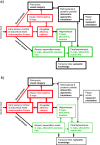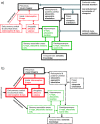Intrusive images in psychological disorders: characteristics, neural mechanisms, and treatment implications
- PMID: 20063969
- PMCID: PMC2834572
- DOI: 10.1037/a0018113
Intrusive images in psychological disorders: characteristics, neural mechanisms, and treatment implications
Abstract
Involuntary images and visual memories are prominent in many types of psychopathology. Patients with posttraumatic stress disorder, other anxiety disorders, depression, eating disorders, and psychosis frequently report repeated visual intrusions corresponding to a small number of real or imaginary events, usually extremely vivid, detailed, and with highly distressing content. Both memory and imagery appear to rely on common networks involving medial prefrontal regions, posterior regions in the medial and lateral parietal cortices, the lateral temporal cortex, and the medial temporal lobe. Evidence from cognitive psychology and neuroscience implies distinct neural bases to abstract, flexible, contextualized representations (C-reps) and to inflexible, sensory-bound representations (S-reps). We revise our previous dual representation theory of posttraumatic stress disorder to place it within a neural systems model of healthy memory and imagery. The revised model is used to explain how the different types of distressing visual intrusions associated with clinical disorders arise, in terms of the need for correct interaction between the neural systems supporting S-reps and C-reps via visuospatial working memory. Finally, we discuss the treatment implications of the new model and relate it to existing forms of psychological therapy.
Figures


Comment in
-
Contextualisation in the revised dual representation theory of PTSD: a response to Pearson and colleagues.J Behav Ther Exp Psychiatry. 2014 Mar;45(1):217-9. doi: 10.1016/j.jbtep.2013.07.011. Epub 2013 Aug 6. J Behav Ther Exp Psychiatry. 2014. PMID: 24041427 Free PMC article.
References
-
- Abrahams S., Pickering A., Polkey C. E., & Morris R. G. (1997). Spatial memory deficits in patients with unilateral damage to the right hippocampal formation. Neuropsychologia, 35, 11–24. - PubMed
-
- Aimone J. B., Wiles J., & Gage F. H. (2006). Potential role for adult neurogenesis in the encoding of time in new memories. Nature Neuroscience, 9, 723–727. - PubMed
-
- American Psychiatric Association. (2000). Diagnostic and statistical manual of mental disorders (4th ed., text rev.). Washington, DC: Author.
-
- Anderson M. C., Ochsner K. N., Kuhl B., Cooper J., Robertson E., Gabrieli S. W., . . . Gabrieli J. D. E. (2004, January9). Neural systems underlying the suppression of unwanted memories. Science, 303, 232–235. - PubMed
-
- Andrews B., Brewin C. R., Philpott R., & Stewart L. (2007). Delayed onset posttraumatic stress disorder: A systematic review of the evidence. American Journal of Psychiatry, 164, 1319–1326. - PubMed

